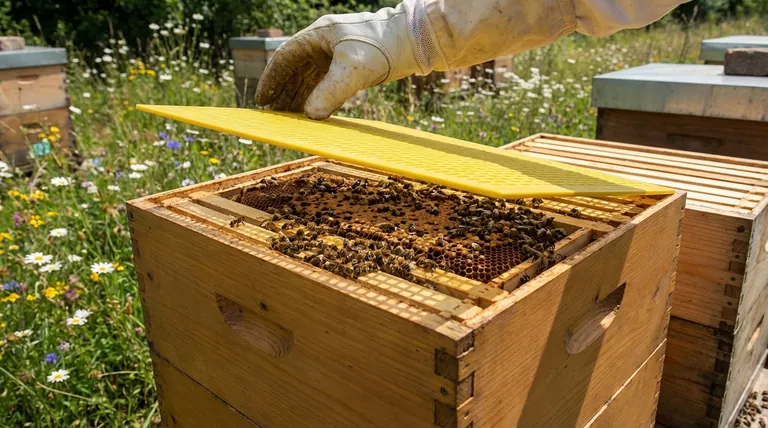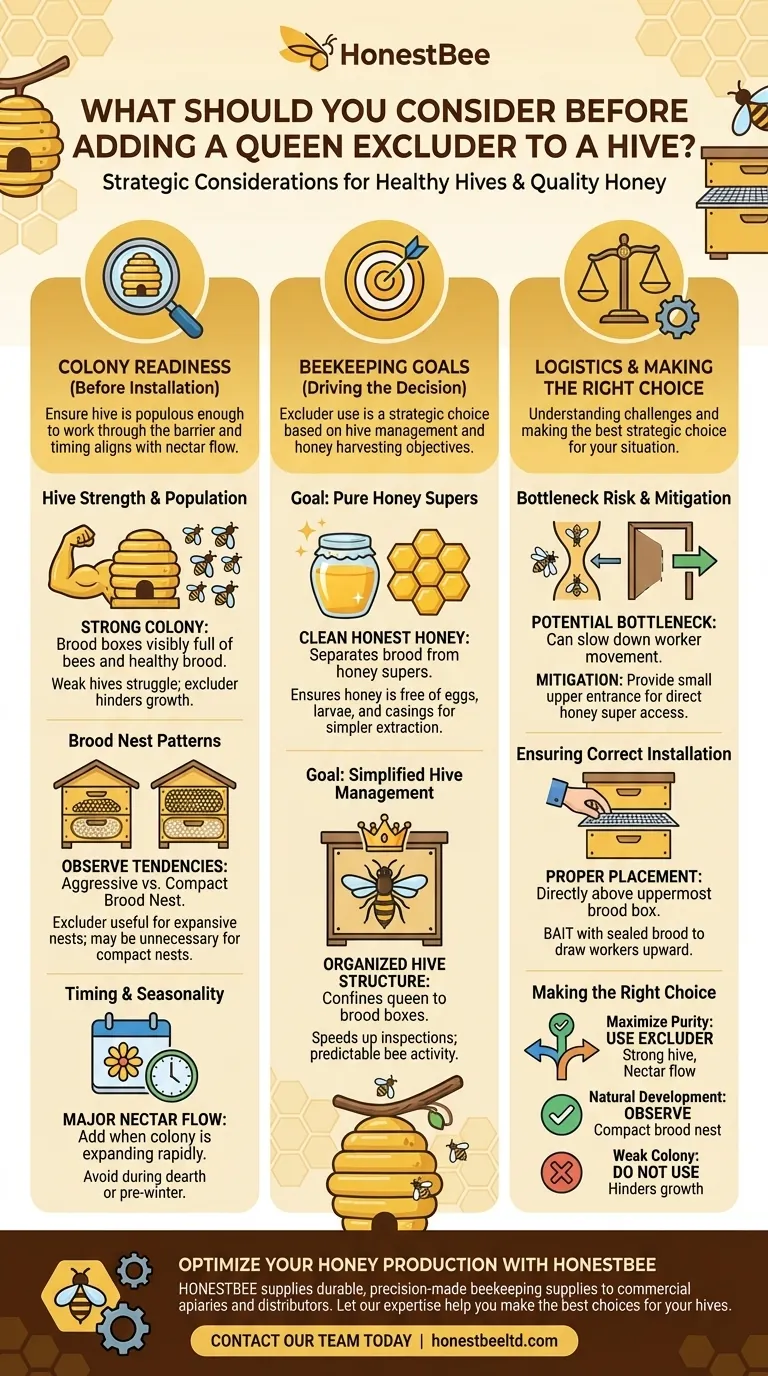Before adding a queen excluder, you must first evaluate your colony’s strength, its natural behavior, and your specific goals as a beekeeper. The primary considerations are ensuring the hive is populous enough to work through the barrier and that the timing aligns with a nectar flow. A queen excluder is a strategic tool for honey production, not a mandatory component for every hive.
A queen excluder is not a default piece of equipment; it is a management tool. Its successful use depends on correctly assessing when the colony is strong enough to justify its use and when your goals for honey purity outweigh the potential drawbacks of impeding bee traffic.

Assessing Your Colony's Readiness
The most common mistake is adding an excluder to a hive that is not prepared for it. Before you install one, a thorough hive inspection is non-negotiable.
Hive Strength and Population
A queen excluder should only be placed on a strong, thriving colony. The brood boxes should be visibly full of bees, with a healthy amount of brood in all stages.
Weak or small hives are poor candidates. The excluder acts as a barrier, and a small population will struggle to pass through it in sufficient numbers to effectively work the honey supers above.
Brood Nest Patterns
Observe your colony's natural tendencies. Some colonies, particularly wild or Africanized bees, aggressively expand their brood nest into any available space. An excluder is very useful for managing this.
Other colonies naturally maintain a modest, compact brood nest in the lower boxes. In these cases, an excluder may be unnecessary, as the queen is less likely to lay eggs in the honey supers.
Timing and Seasonality
An excluder is typically added when you add your first honey super. This should coincide with the start of a major nectar flow when the colony is expanding rapidly.
Consider the weather and time of year. Adding an excluder during a nectar dearth or as a colony is winding down for winter is counterproductive and can stress the hive.
Aligning with Your Beekeeping Goals
Using an excluder is a decision driven by your objectives for hive management and honey harvesting. It fundamentally changes the hive's internal organization.
The Goal: Pure Honey Supers
The primary benefit of an excluder is that it separates the brood chamber from the honey supers. This ensures the honey you harvest is free from eggs, larvae, and pupal casings.
This separation results in cleaner, higher-quality honey and makes the extraction process much simpler, as you don't have to work around patches of brood.
The Goal: Simplified Hive Management
By confining the queen to the brood boxes, you always know where to find her. This can significantly speed up inspections when you need to confirm she is healthy and laying.
This forced organization ensures worker bees perform their roles in designated areas, creating a more orderly and predictable hive structure from a management perspective.
Understanding the Trade-offs and Logistics
While beneficial, a queen excluder is a barrier that can introduce challenges. Proper installation and management are key to mitigating these issues.
The Risk of Creating a Bottleneck
The excluder can slow down worker bees as they move between the brood nest and the honey supers. This can potentially reduce the hive's overall efficiency and honey-gathering pace.
To mitigate this, some beekeepers provide a small upper entrance above the excluder. This gives foraging bees a direct route to the honey supers, reducing traffic through the barrier.
Ensuring Correct Installation
The excluder must be placed directly on top of the uppermost brood box and below the first honey super. It must lie flat and fit tightly, leaving no gaps for the queen to bypass.
When installing, you can move a frame or two containing sealed brood from the brood box into the honey super above. The presence of brood will "bait" or draw worker bees upward through the excluder, encouraging them to start working in the super.
Making the Right Choice for Your Hive
Ultimately, the decision to use a queen excluder is a strategic choice based on your specific situation.
- If your primary focus is maximizing honey purity and simplifying extraction: Use an excluder on strong, productive hives during a major nectar flow.
- If your primary focus is natural hive development and minimizing intervention: Observe your colony's behavior and consider forgoing the excluder, especially if they maintain a compact brood nest on their own.
- If you manage a weak or developing colony: Do not use an excluder, as it will hinder their growth and ability to build the resources they need.
Treating the queen excluder as a deliberate management choice, rather than a standard piece of gear, will lead to healthier hives and better outcomes.
Summary Table:
| Key Consideration | Why It Matters |
|---|---|
| Hive Strength | A strong colony is needed to work through the barrier efficiently. |
| Brood Nest Pattern | Determines if the queen is likely to lay in honey supers. |
| Timing (Nectar Flow) | Should be added when the colony is rapidly expanding. |
| Goal: Honey Purity | Ensures honey supers are free of brood for cleaner extraction. |
| Goal: Hive Management | Confines the queen to brood boxes for easier inspections. |
Optimize your honey production with the right equipment. HONESTBEE supplies durable, precision-made beekeeping supplies and equipment to commercial apiaries and beekeeping equipment distributors through wholesale-focused operations. Let our expertise help you make the best choices for your hives. Contact our team today to discuss your specific needs and elevate your beekeeping operation.
Visual Guide

Related Products
- Professional Plastic Queen Excluder for Modern Beekeeping
- High Performance Plastic Queen Excluder for Beekeeping and Apiary Management
- Premium Wood Framed Metal Wire Queen Bee Excluder
- Plastic Queen Bee Excluder for Bee Hive Wholesale
- Metal Queen Bee Excluder for Beekeeping
People Also Ask
- How does a queen excluder work? Master Hive Management for Pure Honey Harvests
- What are the pros of using queen excluders? Boost Honey Production & Hive Efficiency
- What is the role of a queen excluder when adding a super? Ensure Brood-Free Honey Harvests
- What is the primary function of a queen excluder in beekeeping? Control Hive Layout for Efficient Honey Harvesting
- Why are queen excluders recommended for Flow Hives? Prevent Brood Damage for a Clean Harvest



















